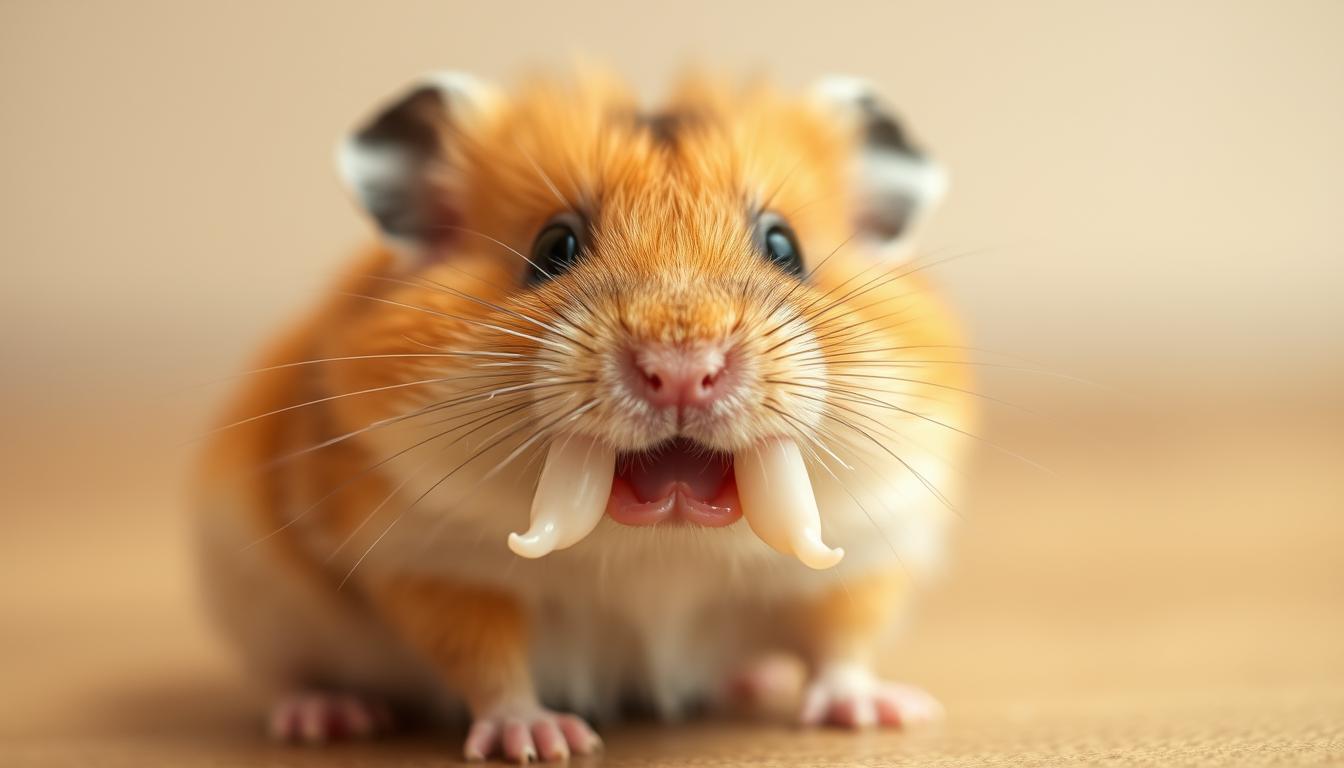Here’s the article about hamster teeth growth rate, formatted as requested:
Hamsters. Those adorable, cheek-stuffing, wheel-running balls of fluff. We love them for their quirky personalities and endless energy. But did you know that beneath that cute exterior lies a dental secret? Hamster teeth never stop growing! It’s a fascinating and crucial aspect of their health that every hamster owner needs to understand. This article will delve into the world of hamster dentition, exploring the growth rate of their teeth, the factors that influence it, and how you can ensure your furry friend maintains a healthy, happy smile. Get ready to learn everything you need to know about those ever-growing chompers!
Hamster Teeth: Never Stop Growing – What’s the Deal?
Imagine your teeth constantly growing. Sounds a little scary, right? Well, that’s the reality for hamsters! Unlike humans, hamsters have open-rooted teeth, meaning their incisors (the front teeth) continuously erupt throughout their lives. This continuous growth is an evolutionary adaptation to their natural diet, which consists of tough seeds, nuts, and roots that require constant gnawing. Without this constant growth, their teeth would quickly wear down to nothing.
This constant growth also presents a unique set of challenges for hamster owners. If the teeth don’t wear down properly, they can become overgrown, leading to a variety of health problems. Think of it like your fingernails – if you don’t trim them, they’ll eventually become too long and uncomfortable. The same principle applies to hamster teeth.
The reason hamster teeth are so special is because of the cells at the base of the teeth. These cells are actively dividing and producing new tooth material, pushing the existing tooth forward. This process is continuous, ensuring that the hamster always has a sharp, functional set of incisors for grinding and chewing.
It’s important to note that only the incisors are constantly growing. The molars, located at the back of the mouth, do not grow continuously. These teeth are primarily used for grinding food into smaller pieces for digestion. Therefore, the focus of dental care for hamsters is primarily on managing the growth of the incisors.
So, next time you see your hamster happily gnawing away at a piece of wood or a seed, remember that they’re not just being cute – they’re actively maintaining their dental health! Understanding this fundamental aspect of hamster anatomy is the first step towards providing them with the best possible care.
The continuous growth of hamster teeth is a testament to the power of adaptation. It’s a remarkable feature that allows them to thrive in their natural environment, but it also requires responsible ownership to ensure their dental health is properly managed.
Tiny Chompers, Big Growth: Understanding Hamster Teeth
Hamster teeth, despite their small size, are incredibly strong and resilient. They are designed to withstand the constant wear and tear of grinding tough foods. However, their strength doesn’t negate the need for proper care and attention. Understanding the structure and function of these tiny chompers is crucial for maintaining your hamster’s overall health.
Hamsters possess a set of incisors, two on the top and two on the bottom, which are the teeth responsible for the continuous growth we’ve been discussing. These incisors are long and curved, perfectly adapted for grasping and gnawing. Their sharp edges allow hamsters to efficiently break down tough materials into manageable pieces.
The color of hamster teeth is also quite distinctive. They are typically yellow or orange, due to the presence of iron in the enamel. This iron helps to strengthen the teeth and make them more resistant to wear. Don’t be alarmed if your hamster’s teeth are not perfectly white – this is perfectly normal and indicates healthy teeth.
Behind the incisors are the molars, located further back in the mouth. These teeth are used for grinding food into smaller particles for digestion. Unlike the incisors, the molars do not continuously grow. They are designed to last the hamster’s entire lifetime.
The alignment of the incisors is also crucial for proper function. The top and bottom incisors should meet evenly, allowing the hamster to effectively gnaw and grind their food. If the teeth are misaligned, it can lead to uneven wear and potentially overgrowth.
Understanding the anatomy of hamster teeth allows you to better appreciate the importance of providing them with appropriate chewing materials and a balanced diet. By knowing what to look for, you can identify potential dental problems early on and seek veterinary care if necessary.
How Fast Do They Grow? Unveiling the Hamster Teeth Rate
So, how fast do these tiny chompers actually grow? While there’s no single, universally agreed-upon number, studies and observations suggest that hamster incisors can grow at a rate of approximately 2-3 millimeters per week. That’s a significant amount of growth for such a small animal!
This rapid growth rate highlights the importance of providing hamsters with ample opportunities to wear down their teeth. Without constant chewing and gnawing, the teeth can quickly become overgrown, leading to serious health problems.
The exact growth rate can vary slightly depending on several factors, including the hamster’s age, diet, and overall health. Younger hamsters may experience slightly faster growth rates than older hamsters, as their bodies are still actively developing.
It’s important to remember that this is just an average growth rate. Some hamsters may experience slightly faster or slower growth, depending on their individual circumstances. The key is to monitor your hamster’s teeth regularly and ensure that they are being properly worn down.
To put this growth rate into perspective, imagine your fingernails growing at a similar pace. You’d need to trim them constantly to keep them at a manageable length! This is precisely why hamsters need access to appropriate chewing materials to prevent overgrowth.
Understanding the approximate growth rate of hamster teeth can help you better anticipate their needs and provide them with the necessary resources to maintain optimal dental health. Regular monitoring and appropriate care are essential for preventing dental problems and ensuring a happy, healthy hamster.
Measuring the Munchers: Figuring Out Hamster Teeth Growth
While you probably won’t be pulling out a tiny ruler to measure your hamster’s teeth every day, understanding how to assess their length and condition is crucial. Visual inspection is the primary method for monitoring teeth growth and identifying potential problems.
A healthy hamster’s incisors should be relatively short and even. They should meet properly, allowing the hamster to effectively gnaw and grind their food. The teeth should also be a healthy yellow or orange color, indicating proper enamel formation.
To assess the length of the teeth, gently observe your hamster’s mouth. The teeth should not be so long that they interfere with eating or cause the hamster discomfort. If the teeth are excessively long or curved, it may be a sign of overgrowth.
You can also assess the alignment of the teeth. The top and bottom incisors should meet evenly. If one tooth is significantly longer than the other, or if the teeth are misaligned, it may indicate a problem that requires veterinary attention.
Another way to assess teeth growth is to observe your hamster’s eating habits. If your hamster is having difficulty eating, dropping food, or showing a lack of interest in chewing, it may be a sign of dental problems.
Regularly checking your hamster’s teeth can help you identify potential problems early on, before they become more serious. Aim to inspect your hamster’s teeth at least once a week, or more frequently if you suspect a problem.
While you can’t precisely measure the growth rate without specialized equipment, these visual assessments will give you a good indication of whether your hamster’s teeth are growing at a healthy rate and being properly worn down. If you have any concerns, it’s always best to consult with a veterinarian experienced in treating small animals.
Factors Affecting Growth: More Than Just Chewing Wood
While chewing is essential for wearing down hamster teeth, several other factors can influence their growth rate and overall health. Understanding these factors can help you provide the best possible care for your furry friend.
Genetics: Just like humans, hamsters can inherit certain genetic predispositions that affect their teeth growth. Some hamsters may naturally have faster or slower growth rates than others.
Diet: A balanced and nutritious diet is crucial for healthy teeth growth. A diet lacking in essential nutrients can weaken the enamel and make the teeth more prone to problems. Conversely, a diet too high in sugar can contribute to dental decay.
Age: Younger hamsters may experience slightly faster teeth growth rates than older hamsters, as their bodies are still actively developing. As hamsters age, their metabolism may slow down, which can also affect teeth growth.
Health Conditions: Certain health conditions, such as malocclusion (misalignment of the teeth), can interfere with the normal wearing down process and lead to overgrowth. Other health problems can also affect the overall health of the teeth.
Environment: The environment in which your hamster lives can also play a role. A stressful or unsanitary environment can weaken the immune system and make the hamster more susceptible to dental problems.
Chewing Materials: The type and availability of chewing materials can significantly impact teeth growth. Providing appropriate chewing materials, such as wooden blocks or mineral stones, can help keep the teeth properly worn down.
By considering these factors, you can create a care plan that supports healthy teeth growth and prevents dental problems. Regular monitoring, a balanced diet, and appropriate chewing materials are all essential for maintaining your hamster’s dental health.
Diet’s Role in Speeding Up or Slowing Down the Growth
Diet plays a pivotal role in managing the growth rate and overall health of hamster teeth. A well-balanced diet not only provides the necessary nutrients for healthy enamel development but also encourages natural chewing behaviors that help wear down the

